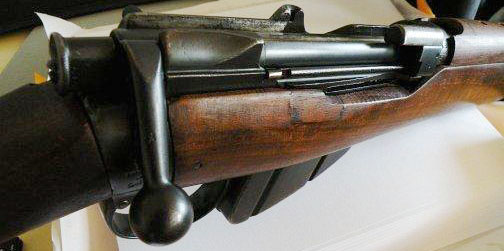|
If Only She Could Speak: A Lee-Enfield No. 1 Mark I*** Rifle By David Tong  I recently happened upon this quite early Lee-Enfield rifle at a local gun shop and snapped her up. As the title of the article suggests, this is a Mark I, which differs from the vast majority of No. 1 rifles. The earliest Enfield rifles were the Lee-Metfords, loaded with black powder cartridges, which went into British service in the late 1880s. These lacked stripper clip or �charger� guides and soldiers of the Empire found in their combat with the Dutch Boers in South Africa that rapid reloading was nearly impossible. The change to Cordite smokeless
powder necessitated a change in the style of rifling and new barrels and sights
were fitted, along with the elimination of the sheet metal action cover. The
original Mark I barrel had an appropriate twist for the older Mark VII 215 grain,
round nose bullet. More importantly, the
engineers at Royal Small Arms Factory, Enfield Lock, fitted the earliest form
of charger guide, to allow stripper clip replenishing of the 10-round magazine.
This took the form of a half-guide fitted to the left outside of the receiver�s
bolt raceway and a peculiar sliding guide fitted to the usual removable bolt
head on the action�s right side. When the bolt is drawn
back, a milled projection on the rear of the split bridge rear receiver pushes
the bolt head charger guide forward, aligning it with the fixed guide on the
left receiver, thus allowing for insertion of the 5-round stripper clip. One of
the interesting things about this rifle system is that the detachable magazine
is supposed to be left in place and replenished with strippers and only one
spare magazine was issued per soldier, in case the original became lost or
damaged in combat. This first attempt at providing charger reloading capability
was overly complex and the later Mark III rifles had the usual U-shaped charger
guide fitted over the action, featured by the vast majority of No. 1 rifles. The Mark I***�s three
asterisks are the result of what are probably WWI or post WWI �FTR,� or
�forward through repair� modifications to bring the older rifle to close to
Mark III standard issue. The original windage adjustable rear sight was
eliminated, along with the upper wooden handguard with its integral protective
ears. Other casualties of the upgrade included the elimination of the �volley
sights,� which massed infantry would have used to provide rapid �plunging fire�
onto enemy troop concentrations, and were normally fitted to the left side
forestock and the left wrist buttstock socket�s thumb safety. However, the rifle now in
my collection still wears the original Mark I sliding charger guide, its first
variation striker and cocking piece, a second variation bottom metal that
accepts the stop clip equipped third variation magazine for the .303 Mark VIII 174
grain spitzer ammunition and the original serial number. The latter confirms
its 1905 manufacture by Enfield Arsenal. The late Professor Charles Stratton of the University of Idaho has written a number of small paperback volumes on the Lee-Enfield rifle system, which are available through North Cape Publications of Tustin, CA. They offer a concise and easily read description of proof marks, development modifications and approximate dates of manufacture from the various countries and arsenals that supplied arms for the Empire on which the sun never set. I found Volume 1 of the series invaluable information for this article. |